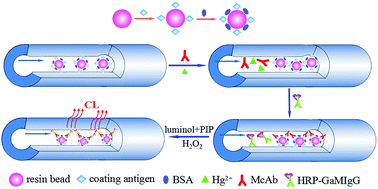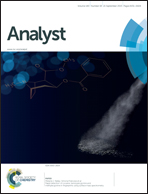Flow injection chemiluminescence immunoassay based on resin beads, enzymatic amplification and a novel monoclonal antibody for determination of Hg2+
Abstract
In the present work, a simple and sensitive flow injection chemiluminescent competitive immunoassay was developed for the determination of mercury(II) ion (Hg2+) based on carboxylic resin beads, a novel specific monoclonal antibody (McAb) and HRP enzyme-amplification. Resin beads with carboxyl groups were creatively employed as supports for immobilizing more coating antigen through acylamide bonds. With a competitive-type assay mode, the Hg2+ in solution competed with the immobilized coating antigen for the limited McAb. Then, the second antibody labeled with HRP was introduced, and an effectively increased CL was obtained, which was ascribed to the catalytic activity of HRP for the luminol–PIP–H2O2 reaction. With increasing concentration of Hg2+, the CL of this system decreases because less HRP is present in the CL reaction. At optimal conditions, the CL signal displayed a good linear relation toward Hg2+ in the range of 0.05–200 ng mL−1 with a detection limit (3σ) of 0.015 ng mL−1. The immunosensor possessed high specificity, acceptable accuracy and reproducibility, and was examined in real samples with favorable results. This immunoassay will have intriguing application prospects for the determination of other heavy metal ions and environmental contaminants.


 Please wait while we load your content...
Please wait while we load your content...